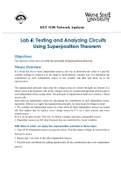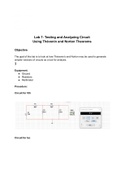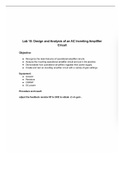EET 3150
Wayne State University
Page 2 out of 21 results
Sort by

-
Lab 6: Testing and Analyzing Circuits Using Superposition Theorem
- Other • 8 pages • 2023
-
- $14.69
- + learn more
The superposition principle states that the voltage across (or current through) an element in a linear circuit is the algebraic sum of the voltages across (or currents through) that element due to each independent source acting alone. The principle of superposition helps us to analyze a linear circuit with more than one independent source by calculating the contribution of each independent source separately. However, to apply the superposition principle, we must keep two things in mind: 1. We ...

-
Lab 7: Testing and Analyzing Circuit Using Thévenin and Norton Theorems
- Other • 9 pages • 2023
-
- $14.69
- + learn more
Thévenin’s Theorem for DC circuits states that any two port linear network may be replaced by a single voltage source with an appropriate internal resistance. The Thévenin equivalent will produce the same load current and voltage as the original circuit to any load. Consequently, if many different loads or sub-circuits are under consideration, using a Thévenin equivalent usually proves to be a much quicker method of analysis. Any complex circuit consisting of multiple sources and components...

-
Lab:10 Design and Analysis of an AC Inverting Amplifier Circuit
- Other • 8 pages • 2023
-
- $14.69
- + learn more
This course will cover the topics in electric network analysis and design. Techniques of electric circuit theory are studied and applied in network analysis and design, operational amplifiers, and related circuits, including the applications with NI Multisim, and MATLAB software packages. Analysis of circuits with dependent sources, basic waveforms, RL, RC, and RLC circuit transients and sinusoidal response, network functions, and power analysis

-
Circuit Elements and Laws Chapter 1
- Other • 82 pages • 2023
-
- $9.59
- + learn more
This course will cover the topics in electric network analysis and design. Techniques of electric circuit theory are studied and applied in network analysis and design, operational amplifiers, and related circuits, including the applications with NI Multisim, and MATLAB software packages. Analysis of circuits with dependent sources, basic waveforms, RL, RC, and RLC circuit transients and sinusoidal response, network functions, and power analysis

-
Resistive Circuits Chapter 3 and 4
- Other • 76 pages • 2023
-
- $9.59
- + learn more
This course will cover the topics in electric network analysis and design. Techniques of electric circuit theory are studied and applied in network analysis and design, operational amplifiers, and related circuits, including the applications with NI Multisim, and MATLAB software packages. Analysis of circuits with dependent sources, basic waveforms, RL, RC, and RLC circuit transients and sinusoidal response, network functions, and power analysis

-
Circuit Theorems Chapter 5
- Other • 103 pages • 2023
-
- $9.59
- + learn more
This course will cover the topics in electric network analysis and design. Techniques of electric circuit theory are studied and applied in network analysis and design, operational amplifiers, and related circuits, including the applications with NI Multisim, and MATLAB software packages. Analysis of circuits with dependent sources, basic waveforms, RL, RC, and RLC circuit transients and sinusoidal response, network functions, and power analysis

-
Energy Storage Chapter 7
- Other • 85 pages • 2023
-
- $9.59
- + learn more
In this docu, we will introduce two new and important passive linear circuit elements: Capacitors Inductors • Unlike resistors, which dissipate energy, capacitors and inductors do not dissipate but store energy, which can be retrieved at a later time. For this reason, capacitors and inductors are called storage elements. • We begin by introducing capacitors and describing how to combine them in series or in parallel. Later, we do the same for inductors. • Also, we will explore ...

-
Electrical sources And switches chapter 2
- Other • 33 pages • 2023
-
- $9.59
- + learn more
This course will cover the topics in electric network analysis and design. Techniques of electric circuit theory are studied and applied in network analysis and design, operational amplifiers, and related circuits, including the applications with NI Multisim, and MATLAB software packages. Analysis of circuits with dependent sources, basic waveforms, RL, RC, and RLC circuit transients and sinusoidal response, network functions, and power analysis .

-
Methods of Analysis of Resistive Circuit Chapter 5a
- Other • 47 pages • 2023
-
- $9.59
- + learn more
This course will cover the topics in electric network analysis and design. Techniques of electric circuit theory are studied and applied in network analysis and design, operational amplifiers, and related circuits, including the applications with NI Multisim, and MATLAB software packages. Analysis of circuits with dependent sources, basic waveforms, RL, RC, and RLC circuit transients and sinusoidal response, network functions, and power analysis

-
Resistive Circuits chapter 3
- Other • 45 pages • 2023
-
- $9.59
- + learn more
This course will cover the topics in electric network analysis and design. Techniques of electric circuit theory are studied and applied in network analysis and design, operational amplifiers, and related circuits, including the applications with NI Multisim, and MATLAB software packages. Analysis of circuits with dependent sources, basic waveforms, RL, RC, and RLC circuit transients and sinusoidal response, network functions, and power analysis

How much did you already spend on Stuvia? Imagine there are plenty more of you out there paying for study notes, but this time YOU are the seller. Ka-ching! Discover all about earning on Stuvia


